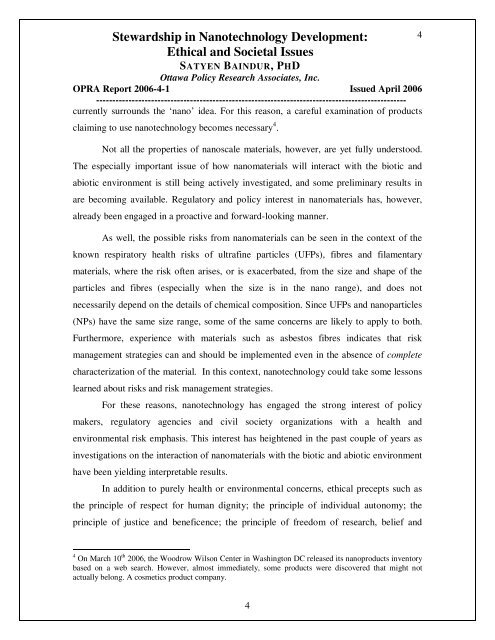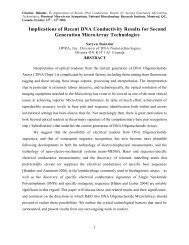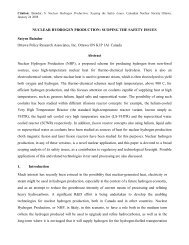Development Ethical and Societal Issues Satyen Baindur PhD
Ethical and Societal Issues - Satyen.Baindur.Org
Ethical and Societal Issues - Satyen.Baindur.Org
You also want an ePaper? Increase the reach of your titles
YUMPU automatically turns print PDFs into web optimized ePapers that Google loves.
Stewardship in Nanotechnology <strong>Development</strong>:<br />
<strong>Ethical</strong> <strong>and</strong> <strong>Societal</strong> <strong>Issues</strong><br />
SATYEN BAINDUR, PHD<br />
Ottawa Policy Research Associates, Inc.<br />
OPRA Report 2006-4-1 Issued April 2006<br />
------------------------------------------------------------------------------------------------<br />
currently surrounds the ‘nano’ idea. For this reason, a careful examination of products<br />
claiming to use nanotechnology becomes necessary 4 .<br />
Not all the properties of nanoscale materials, however, are yet fully understood.<br />
The especially important issue of how nanomaterials will interact with the biotic <strong>and</strong><br />
abiotic environment is still being actively investigated, <strong>and</strong> some preliminary results in<br />
are becoming available. Regulatory <strong>and</strong> policy interest in nanomaterials has, however,<br />
already been engaged in a proactive <strong>and</strong> forward-looking manner.<br />
As well, the possible risks from nanomaterials can be seen in the context of the<br />
known respiratory health risks of ultrafine particles (UFPs), fibres <strong>and</strong> filamentary<br />
materials, where the risk often arises, or is exacerbated, from the size <strong>and</strong> shape of the<br />
particles <strong>and</strong> fibres (especially when the size is in the nano range), <strong>and</strong> does not<br />
necessarily depend on the details of chemical composition. Since UFPs <strong>and</strong> nanoparticles<br />
(NPs) have the same size range, some of the same concerns are likely to apply to both.<br />
Furthermore, experience with materials such as asbestos fibres indicates that risk<br />
management strategies can <strong>and</strong> should be implemented even in the absence of complete<br />
characterization of the material. In this context, nanotechnology could take some lessons<br />
learned about risks <strong>and</strong> risk management strategies.<br />
For these reasons, nanotechnology has engaged the strong interest of policy<br />
makers, regulatory agencies <strong>and</strong> civil society organizations with a health <strong>and</strong><br />
environmental risk emphasis. This interest has heightened in the past couple of years as<br />
investigations on the interaction of nanomaterials with the biotic <strong>and</strong> abiotic environment<br />
have been yielding interpretable results.<br />
In addition to purely health or environmental concerns, ethical precepts such as<br />
the principle of respect for human dignity; the principle of individual autonomy; the<br />
principle of justice <strong>and</strong> beneficence; the principle of freedom of research, belief <strong>and</strong><br />
4<br />
4 On March 10 th 2006, the Woodrow Wilson Center in Washington DC released its nanoproducts inventory<br />
based on a web search. However, almost immediately, some products were discovered that might not<br />
actually belong. A cosmetics product company.<br />
4










